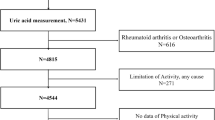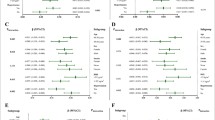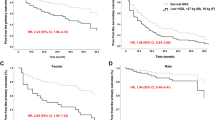Abstract
Background
Hyperglycemia induces heightened oxidative stress, potentially leading to reduced muscle strength. Consequently, compounds with antioxidant properties could potentially offer protection against this decline. Uric acid (UA) is known for its antioxidant effects and has shown a positive association with muscle strength in older adults. However, whether this association extends to older adults with hyperglycemia remains unknown.
Aim
To assess the association between UA levels and muscle strength in older adults, stratified by glycosylated hemoglobin levels.
Methods
A cross-sectional study was conducted, involving 2380 individuals aged 50 to 85 years (1500 normoglycemic and 880 hyperglycemic), selected from a subsample of the National Health and Nutrition Examination Survey (NHANES) 1999–2002. Hyperglycemia was defined as glycosylated hemoglobin levels ≥ 5.7%. Muscle strength was assessed using a kinetic communicator isokinetic dynamometer. Serum UA levels were measured using a colorimetric method. Linear regression analyses were employed to examine the association of continuous UA values and tertiles of UA levels with muscle strength based on glycemic status, adjusting for potential confounding factors.
Results
Tertiles of UA levels showed a positive association with peak force in individuals with hyperglycemia (p-trend = 0.013), but not in those with normoglycemia (p-trend = 0.077). Moreover, continuous UA values were positively associated with muscle strength in older adults with hyperglycemia (β = 5.2 (0.6; 9.8); p = 0.027), whereas no association was observed in those with normal glycemia (β = 2.4 (− 2.1; 6.9); p = 0.282).
Conclusion
Serum UA exhibits a positive association with muscle strength in older adults with hyperglycemia; however, this association is not observed in individuals with normal glucose levels. These results suggest that UA levels may play a crucial role in muscle strength, particularly in older adults experiencing heightened oxidative stress induced by hyperglycemia.


Similar content being viewed by others
Data availability
The dataset generated and analyzed during the current study is available from the corresponding author on reasonable request.
References
McGregor RA, Cameron-Smith D, Poppitt SD. It is not just muscle mass: a review of muscle quality, composition and metabolism during ageing as determinants of muscle function and mobility in later life. Longev Healthspan. 2014;3(1):9.
Wang X, Ma Y, Wang J, Han P, Dong R, Kang L, Zhang W, Shen S, Wang J, Li D, et al. Mobility and muscle strength together are more strongly correlated with falls in suburb-dwelling older Chinese. Sci Rep. 2016;6:25420.
Uusi-Rasi K, Karinkanta S, Tokola K, Kannus P, Sievänen H. Bone mass and strength and fall-related fractures in older age. J Osteoporos. 2019;2019:5134690.
Langhammer B, Bergland A, Rydwik E. The importance of physical activity exercise among older people. Biomed Res Int. 2018;2018:7856823.
Bartels EM, Robertson S, Danneskiold-Samsøe B, Appleyard M, Stockmarr A. Effects of lifestyle on muscle strength in a healthy Danish population. J Lifestyle Med. 2018;8(1):16–22.
Lee MR, Jung SM, Bang H, Kim HS, Kim YB. Association between muscle strength and type 2 diabetes mellitus in adults in Korea: data from the Korea National Health and Nutrition Examination Survey (KNHANES) VI. Medicine (Baltimore). 2018;97(23):e10984.
Mainous AG 3rd, Tanner RJ, Anton SD, Jo A. Grip strength as a marker of hypertension and diabetes in healthy weight adults. Am J Prev Med. 2015;49(6):850–8.
Gregorio L, Brindisi J, Kleppinger A, Sullivan R, Mangano KM, Bihuniak JD, Kenny AM, Kerstetter JE, Insogna KL. Adequate dietary protein is associated with better physical performance among post-menopausal women 60–90 years. J Nutr Health Aging. 2014;18(2):155–60.
Bruno RR, Rosa FC, Nahas PC, de Branco F, de Oliveira EP. Serum α-carotene, but not other antioxidants, is positively associated with muscle strength in older adults: NHANES 2001–2002. Antioxidants. 2022;11(12):2386.
Lobo PC, de Branco FM, Pichard C, de Oliveira EP, Pimentel GD. C-reactive protein, but not neutrophil-lymphocyte ratio, is inversely associated with muscle strength only in older men: NHANES 1999–2002. Exp Gerontol. 2023;173:112084.
Fulle S, Protasi F, Di Tano G, Pietrangelo T, Beltramin A, Boncompagni S, Vecchiet L, Fanò G. The contribution of reactive oxygen species to sarcopenia and muscle ageing. Exp Gerontol. 2004;39(1):17–24.
Park SW, Goodpaster BH, Lee JS, Kuller LH, Boudreau R, de Rekeneire N, Harris TB, Kritchevsky S, Tylavsky FA, Nevitt M, et al. Excessive loss of skeletal muscle mass in older adults with type 2 diabetes. Diabetes Care. 2009;32(11):1993–7.
Park SW, Goodpaster BH, Strotmeyer ES, Kuller LH, Broudeau R, Kammerer C, de Rekeneire N, Harris TB, Schwartz AV, Tylavsky FA, et al. Accelerated loss of skeletal muscle strength in older adults with type 2 diabetes: the health, aging, and body composition study. Diabetes Care. 2007;30(6):1507–12.
Batista RA, de Branco FM, Nehme R, de Oliveira EP. Pena GdG: Association between plasma omega-3 and handgrip strength according to glycohemoglobin levels in older adults: results from NHANES 2011–2012. Nutrients. 2022;14(19):4060.
Barzilay JI, Cotsonis GA, Walston J, Schwartz AV, Satterfield S, Miljkovic I, Harris TB. Insulin resistance is associated with decreased quadriceps muscle strength in nondiabetic adults aged >or=70 years. Diabetes Care. 2009;32(4):736–8.
Kalyani RR, Metter EJ, Ramachandran R, Chia CW, Saudek CD, Ferrucci L. Glucose and insulin measurements from the oral glucose tolerance test and relationship to muscle mass. J Gerontol A Biol Sci Med Sci. 2012;67(1):74–81.
Fougere B, van Kan GA, Vellas B, Cesari M. Redox systems, antioxidants and sarcopenia. Curr Protein Pept Sci. 2018;19(7):643–8.
de Oliveira EP, Burini RC. High plasma uric acid concentration: causes and consequences. Diabetol Metab Syndr. 2012;4:12.
Nahas PC, Rossato LT, de Branco FMS, Azeredo CM, Rinaldi AEM, de Oliveira EP. Serum uric acid is positively associated with muscle strength in older men and women: findings from NHANES 1999–2002. Clin Nutr. 2021;40(6):4386–93.
Floriano JP, Nahas PC, de Branco FMS, Dos Reis AS, Rossato LT, Santos HO, Limirio LS, Ferreira-Filho SR, de Oliveira EP. Serum uric acid is positively associated with muscle mass and strength, but not with functional capacity, in kidney transplant patients. Nutrients. 2020;12(8):2390.
Lee J, Hong YS, Park SH, Kang KY. High serum uric acid level is associated with greater handgrip strength in the aged population. Arthritis Res Ther. 2019;21(1):73.
Kawamoto R, Ninomiya D, Kasai Y, Kusunoki T, Ohtsuka N, Kumagi T, Abe M. Serum uric acid is positively associated with handgrip strength among Japanese community-dwelling elderly women. PLoS ONE. 2016;11(4):e0151044.
Wu Y, Zhang D, Pang Z, Jiang W, Wang S, Tan Q. Association of serum uric acid level with muscle strength and cognitive function among Chinese aged 50–74 years. Geriatr Gerontol Int. 2013;13(3):672–7.
Macchi C, Molino-Lova R, Polcaro P, Guarducci L, Lauretani F, Cecchi F, Bandinelli S, Guralnik JM, Ferrucci L. Higher circulating levels of uric acid are prospectively associated with better muscle function in older persons. Mech Ageing Dev. 2008;129(9):522–7.
Molino-Lova R, Sofi F, Pasquini G, Vannetti F, Del Ry S, Vassalle C, Clerici M, Sorbi S, Macchi C. Higher uric acid serum levels are associated with better muscle function in the oldest old: results from the Mugello Study. Eur J Intern Med. 2017;41:39–43.
Nehme R, Nahas PC, de Oliveira EP. Association between serum uric acid and muscle strength in older adults with or without gout diagnosis: NHANES 2011–2014. Aging Clin Exp Res. 2023:1–6.
Nahas PC, de Branco FM, Azeredo CM, Rinaldi AEM, de Oliveira EP. Serum uric acid is not associated with appendicular muscle mass index in young and middle-aged adults: results from NHANES 2011–2012. Clin Nutr ESPEN. 2022;52:262–9.
García-Esquinas E, Rodríguez-Artalejo F. Association between serum uric acid concentrations and grip strength: is there effect modification by age? Clin Nutr. 2018;37(2):566–72.
Control CfD, Prevention. National Health and Nutrition Examination Survey Data. Hyattsville, MD: US Department of Health and Human Services, Centers for Disease Control and Prevention. In.; 1999 ─ 2002.
Dodds RM, Syddall HE, Cooper R, Benzeval M, Deary IJ, Dennison EM, Der G, Gale CR, Inskip HM, Jagger C. Grip strength across the life course: normative data from twelve British studies. PLoS ONE. 2014;9(12):e113637.
Kuo HK, Leveille SG, Yen CJ, Chai HM, Chang CH, Yeh YC, Yu YH, Bean JF. Exploring how peak leg power and usual gait speed are linked to late-life disability: data from the National Health and Nutrition Examination Survey (NHANES), 1999–2002. Am J Phys Med Rehabil. 2006;85(8):650–8.
Association AD. 2 Classification and diagnosis of diabetes: standards of medical care in diabetes-2021. Diabetes care. 2021;44(Suppl 1):S15-s33.
Levey AS, Stevens LA, Schmid CH, Zhang YL, Castro AF 3rd, Feldman HI, Kusek JW, Eggers P, Van Lente F, Greene T, et al. A new equation to estimate glomerular filtration rate. Ann Intern Med. 2009;150(9):604–12.
Lohman TG, Roche AF, Martorell R. Anthropometric standardization reference manual: Human kinetics books; 1988.
Quetelet A. A treatise on man and the development of his faculties: now first translated into English: William and Robert Chambers; 1842.
Centers for Disease Control and Prevention. Available from: https://wwwn.cdc.gov/Nchs/Nhanes/1999-2000/LAB11.htm. 1999–2000.
Centers for Disease Control and Prevention. Available from: https://wwwn.cdc.gov/Nchs/Nhanes/2001-2002/DRXTOT_B.htm. 2001–2002.
Rossato LT, de Branco FMS, Azeredo CM, Rinaldi AEM, de Oliveira EP. Association between omega-3 fatty acids intake and muscle strength in older adults: a study from National Health and Nutrition Examination Survey (NHANES) 1999–2002. Clin Nutr. 2020;39(11):3434–41.
de Oliveira EP, Moreto F, Silveira LV, Burini RC. Dietary, anthropometric, and biochemical determinants of uric acid in free-living adults. Nutr J. 2013;12:11.
Giacco F, Brownlee M. Oxidative stress and diabetic complications. Circ Res. 2010;107(9):1058–70.
Chong CR, Clarke K, Levelt E. Metabolic remodeling in diabetic cardiomyopathy. Cardiovasc Res. 2017;113(4):422–30.
Cochemé HM, Quin C, McQuaker SJ, Cabreiro F, Logan A, Prime TA, Abakumova I, Patel JV, Fearnley IM, James AM, et al. Measurement of H2O2 within living Drosophila during aging using a ratiometric mass spectrometry probe targeted to the mitochondrial matrix. Cell Metab. 2011;13(3):340–50.
Jang YC, Lustgarten MS, Liu Y, Muller FL, Bhattacharya A, Liang H, Salmon AB, Brooks SV, Larkin L, Hayworth CR, et al. Increased superoxide in vivo accelerates age-associated muscle atrophy through mitochondrial dysfunction and neuromuscular junction degeneration. Faseb J. 2010;24(5):1376–90.
Glantzounis GK, Tsimoyiannis EC, Kappas AM, Galaris DA. Uric acid and oxidative stress. Curr Pharm Des. 2005;11(32):4145–51.
Feig DI, Kang DH, Johnson RJ. Uric acid and cardiovascular risk. N Engl J Med. 2008;359(17):1811–21.
Lv Q, Meng XF, He FF, Chen S, Su H, Xiong J, Gao P, Tian XJ, Liu JS, Zhu ZH, et al. High serum uric acid and increased risk of type 2 diabetes: a systemic review and meta-analysis of prospective cohort studies. PLoS ONE. 2013;8(2):e56864.
Hayden MR, Tyagi SC. Uric acid: a new look at an old risk marker for cardiovascular disease, metabolic syndrome, and type 2 diabetes mellitus: the urate redox shuttle. Nutr Metab (Lond). 2004;1(1):10–10.
Richette P, Bardin T. Gout. Lancet (London, England). 2010;375(9711):318–28.
Larsen ML, Hørder M, Mogensen EF. Effect of long-term monitoring of glycosylated hemoglobin levels in insulin-dependent diabetes mellitus. N Engl J Med. 1990;323(15):1021–5.
Acknowledgements
EPO acknowledges The Brazilian National Council for Scientific and Technological Development (CNPq, Brazil, 307786/2022-6) for their support and contribution. We thank CAPES for financial support.
Author information
Authors and Affiliations
Contributions
BBS contributed to data interpretation, conducted statistical analysis, and authored the manuscript; LSL and RN conducted statistical analysis, participated in data interpretation, and contributed to manuscript revisions; PCN and FMSB were involved in dataset configuration, statistical analysis, and manuscript revisions; EPO contributed to data interpretation, manuscript writing, and manuscript revision. All authors reviewed and approved the final version of the manuscript.
Corresponding author
Ethics declarations
Ethical approval
NHANES data collection protocols are approved by the ethics review board of the National Center for Health Statistics.
Consent to participate
Informed consent was obtained from all individual participants included in the study.
Competing interests
Erick P. de Oliveira is an Associate Editor for Nutrire and the peer-review process for this article was independently handled by another member of the journal editorial board. The other authors declare no competing interests.
Supplementary Information
Below is the link to the electronic supplementary material.
Rights and permissions
Springer Nature or its licensor (e.g. a society or other partner) holds exclusive rights to this article under a publishing agreement with the author(s) or other rightsholder(s); author self-archiving of the accepted manuscript version of this article is solely governed by the terms of such publishing agreement and applicable law.
About this article
Cite this article
Batista-da-Silva, B., Nahas, P.C., Limirio, L.S. et al. Association between serum uric acid and muscle strength according to glycemic status in older adults: NHANES 1999–2002. Nutrire 49, 27 (2024). https://doi.org/10.1186/s41110-024-00269-4
Received:
Accepted:
Published:
DOI: https://doi.org/10.1186/s41110-024-00269-4




